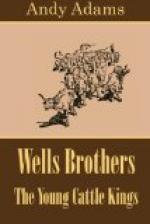A hopeful spirit lightened every task. The calves and their mothers were brought down to the home corral and branded in a single day. The Stoddard cattle, the title being conditional, were exempt, the Lazy H ranch brand fully protecting mutual interests. Only cripple, fagged, and stray cattle were branded, the latter numbering less than a hundred head, and were run into the Hospital brand, while the remainder bore the—Y of the ranch. The work was completed within a week, Dell making a hand which proved his nerve, either in the saddle or branding pen.
The first week in October was devoted to building the new dug-out and stable. The wagon was provisioned, every implement and tool on the ranch, from a hammer to a plough, was taken along, as well as the remuda, and the quartette sallied forth to the task as if it were a frolic. The site had been decided on during the haying, and on reaching the scene, the tent was set up, and the building of a shelter for man and horse was begun.
The dug-out of the West is built for comfort,—half cellar and the remainder sod walls. A southern slope was selected; an abrupt break or low bank was taken advantage of, admitting of four-foot cellar walls on three sides, the open end inclosed with massive sod walls and containing the door. The sod was broken by a team and plough, cut into lengths like brick, and the outside walls raised to the desired height. For roofing, a heavy ridge-pole was cut the length of the room, resting on stout upright posts. Lighter poles were split and laid compactly, like rafters, sheeted with hay, and covered with loose dirt to the depth of a foot. The floor was earthen; a half window east and west, supplemented by a door in the south, admitted light, making a cosy, comfortable shelter. A roomy stable was built on the same principle and from the same material.
The work was completed quickly, fuel for the winter gathered, when the quartette started homeward. “It looks like the halfway house at Land’s End,” said Manly, turning for a last look at the new improvements. “What are you going to call the new tepee?”
“Going to call it The Wagon,” answered Sargent, he and Dell having accepted the new line-camp as their winter quarters, “and let the latch-string hang on the outside. Whenever you can, you must bring your knitting and come over.”
CHAPTER XVIII
AN OPEN WINTER
An ideal Indian summer was enjoyed. Between the early and late fall frosts, the range matured into perfect winter pasturage. Light rains in September freshened the buffalo grass until it greened on the sunny slopes, cured into hay as the fall advanced, thus assuring abundant forage to the cattle.
Manly was the only one of the quartette not inured to a northern climate. A winter in Montana had made Sargent proof against any cold, while the brothers were native to that latitude if not to the plains. After building the line-camp and long before occupying it, the quartette paired off, Sargent and Dell claiming the new dug-out, while the other two were perfectly content with the old shack at headquarters. A healthy spirit of rivalry sprang up, extending from a division of the horses down to a fair assignment of the blankets.




